耶鲁大学公开课 博弈论12
game theory12 博弈论 英文 例题详细解析
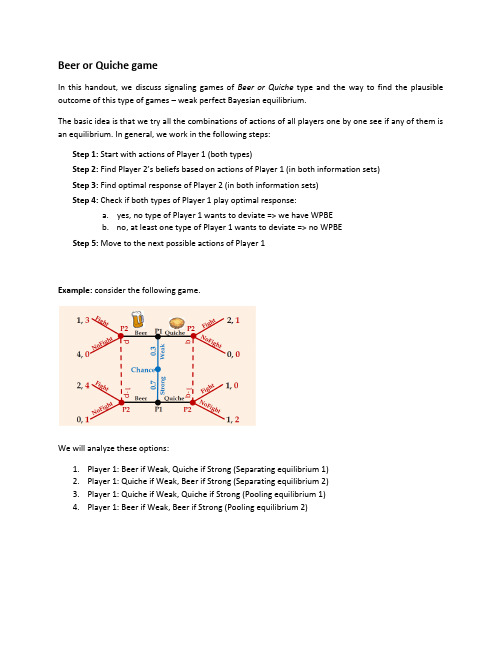
Beer or Quiche gameIn this handout, we discuss signaling games of Beer or Quiche type and the way to find the plausible outcome of this type of games – weak perfect Bayesian equilibrium.The basic idea is that we try all the combinations of actions of all players one by one see if any of them is an equilibrium. In general, we work in the following steps:Step 1: Start with actions of Player 1 (both types)Step 2:Find Player 2’s beliefs ba sed on actions of Player 1 (in both information sets)Step 3: Find optimal response of Player 2 (in both information sets)Step 4: Check if both types of Player 1 play optimal response:a.yes, no type of Player 1 wants to deviate => we have WPBEb.no, at least one type of Player 1 wants to deviate => no WPBEStep 5: Move to the next possible actions of Player 1Example: consider the following game.We will analyze these options:1.Player 1: Beer if Weak, Quiche if Strong (Separating equilibrium 1)2.Player 1: Quiche if Weak, Beer if Strong (Separating equilibrium 2)3.Player 1: Quiche if Weak, Quiche if Strong (Pooling equilibrium 1)4.Player 1: Beer if Weak, Beer if Strong (Pooling equilibrium 2)Option 1: Player 1: Beer if Weak, Quiche if Strong (Separating equilibrium 1)Step 1: Start with actions of Player 1 (both types)Beer if Weak, Quiche if StrongStep 2:Find Player 2’s beliefs based on actions of Player 1 (in both information sets)Information sets are reached, so beliefs are calculated based on actions of Player 1.Step 3: Find optimal response of Player 2 (in both information sets)In the left information set, Player 1 knows that Player 2 is of Weak type and Fighting is optimal (3>0).In the right information set, Player 2 knows that Player 1 is of Strong type and Not Fighting is optimal(2>0).Step 4: Check if both types of Player 1 play optimal responseWeak type of Player 1 is satisfied, but Strong type of Player 1 wants to deviate and get higher profit.So this is not WPBE.Step 5: Move to the next possible actions of Player 1Option 2: Player 1: Quiche if Weak, Beer if Strong (Separating equilibrium 2) Step 1: Start with actions of Player 1 (both types)Quiche if Weak, Beer if StrongStep 2:Find Player 2’s beliefs based on actions of Player 1 (in both information sets)Information sets are reached, so beliefs are calculated based on actions of Player 1.Step 3: Find optimal response of Player 2 (in both information sets)In the left information set, Player 1 knows that Player 2 is of Strong type and Fighting is optima (4>1).In the right information set, Player 2 knows that Player 1 is of Weak type and Fighting is optimal(1>0).Step 4: Check if both types of Player 1 play optimal responseNo type of Player 1 wants to deviate because the payoff would be lower. So this is WPBE.Step 5: Move to the next possible actions of Player 1Option 3: Player 1: Quiche if Weak, Quiche if Strong (Pooling equilibrium 1) Step 1: Start with actions of Player 1 (both types)Quiche if Weak, Quiche if StrongStep 2:Find Player 2’s beliefs based on actions of Player 1 (in both information sets)Right information set is reached, so beliefs are calculated based on actions of Player 1. Left information set is not reached, so we are free to choose any beliefs, any set of beliefs is consistent with Player 1’s actions. Denote beliefs p and 1-p.Step 3: Find optimal response of Player 2 (in both information sets)In the right information set, Player 2 calculates expected payoff of playing Fight and NotFigt:EP(Fight) = 0.3*1+0.7*0 = 0.3EP(NotFight) = 0.3*0+0.7*2 = 1.4So NotFight is optimal response.In the left information set, optimal response of Player 2 generally depends on value of p (beliefs). However, in this case, Fight dominates NotFight in the left information set and hence Fight is optimal.Step 4: Check if both types of Player 1 play optimal responseActually, no matter what action Player 2 chooses in the left information set, Weak type of Player 1 will always want to deviate. So this is not WPBE.Step 5: Move to the next possible actions of Player 1Option 4: Player 1: Beer if Weak, Beer if Strong (Pooling equilibrium 2)Step 1: Start with actions of Player 1 (both types)Beer if Weak, Beer if StrongStep 2:Find Player 2’s beliefs based on actions of Player 1 (in both information sets)Left information set is reached, so beliefs are calculated based on actions of Player 1. Beliefs in the right information set are denoted p and 1-p because this information set is not reached and hence any set of beliefs is consistent with actions of P1..Step 3: Find optimal response of Player 2 (in both information sets)In the left information set, Player 2 calculates expected payoff of playing Fight and NotFigt:EP(Fight) = 0.3*3+0.7*4 = 3.7EP(NotFight) = 0.3*0+0.7*1 = 0.7So Fight is optimal response.In the right information set, optimal response of Player 2 generally depends on value of p (beliefs).There are two options, either the optimal response is Fight, but then Weak Player 1 would want to deviate; or the optimal response is NotFight. In this case no type of Player 1 would want to deviate.So the beliefs have to be set such that expected payoff from NotFight is larger than from Fight.EP(Fight) < EP(NotFight) => 1*p + 0*(1-p) < 0*p + 2*(1-p) => p<2/3Step 4: Check if both types of Player 1 play optimal responseNo type of Player 1 wants to deviate because the payoff would be lower. So this is WPBE.Step 5: Move to the next possible actions of Player 1. There are no more possibilities.There are two WPBE in this game:1.Weak P1 –Quiche, Strong P1 –Beer; P2 Fight if Beer and Fight if Quiche and p=0 in the leftinformation set and p=1 in the right information set.2.Weak P1 – Beer, Strong P1 – Beer; P2 – Fight if Beer and NotFight if Quiche and p<2/3.。
耶鲁大学公开课英文讲义—博弈论第一节
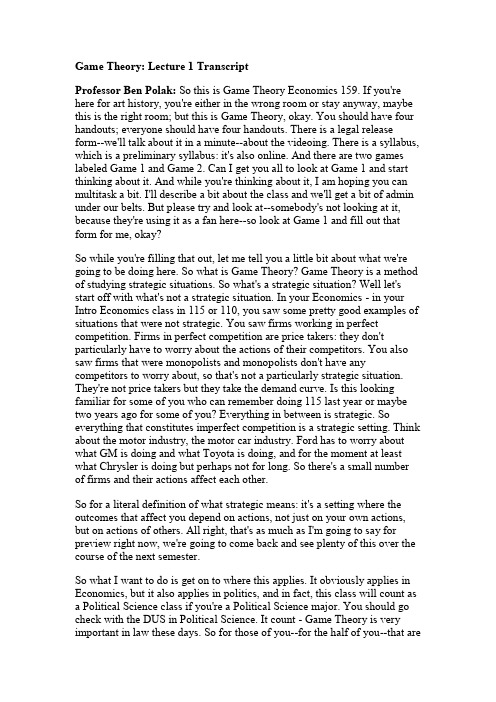
Game Theory: Lecture 1 TranscriptProfessor Ben Polak: So this is Game Theory Economics 159. If you're here for art history, you're either in the wrong room or stay anyway, maybe this is the right room; but this is Game Theory, okay. You should have four handouts; everyone should have four handouts. There is a legal release form--we'll talk about it in a minute--about the videoing. There is a syllabus, which is a preliminary syllabus: it's also online. And there are two games labeled Game 1 and Game 2. Can I get you all to look at Game 1 and start thinking about it. And while you're thinking about it, I am hoping you can multitask a bit. I'll describe a bit about the class and we'll get a bit of admin under our belts. But please try and look at--somebody's not looking at it, because they're using it as a fan here--so look at Game 1 and fill out that form for me, okay?So while you're filling that out, let me tell you a little bit about what we're going to be doing here. So what is Game Theory? Game Theory is a method of studying strategic situations. So what's a strategic situation? Well let's start off with what's not a strategic situation. In your Economics - in your Intro Economics class in 115 or 110, you saw some pretty good examples of situations that were not strategic. You saw firms working in perfect competition. Firms in perfect competition are price takers: they don't particularly have to worry about the actions of their competitors. You also saw firms that were monopolists and monopolists don't have any competitors to worry about, so that's not a particularly strategic situation. They're not price takers but they take the demand curve. Is this looking familiar for some of you who can remember doing 115 last year or maybe two years ago for some of you? Everything in between is strategic. So everything that constitutes imperfect competition is a strategic setting. Think about the motor industry, the motor car industry. Ford has to worry about what GM is doing and what Toyota is doing, and for the moment at least what Chrysler is doing but perhaps not for long. So there's a small number of firms and their actions affect each other.So for a literal definition of what strategic means: it's a setting where the outcomes that affect you depend on actions, not just on your own actions, but on actions of others. All right, that's as much as I'm going to say for preview right now, we're going to come back and see plenty of this over the course of the next semester.So what I want to do is get on to where this applies. It obviously applies in Economics, but it also applies in politics, and in fact, this class will count as a Political Science class if you're a Political Science major. You should go check with the DUS in Political Science. It count - Game Theory is very important in law these days. So for those of you--for the half of you--that aregoing to end up in law school, this is pretty good training. Game Theory is also used in biology and towards the middle of the semester we're actually going to see some examples of Game Theory as applied to evolution. And not surprisingly, Game Theory applies to sport.So let's talk about a bit of admin. How are you doing on filling out those games? Everyone managing to multitask: filling in Game 1? Keep writing. I want to get some admin out of the way and I want to start by getting out of the way what is obviously the elephant in the room. Some of you will have noticed that there's a camera crew here, okay. So as some of you probably know, Yale is undergoing an open education project and they're videoing several classes, and the idea of this, is to make educational materials available beyond the walls of Yale. In fact, on the web, internationally, so people in places, maybe places in the U.S. or places miles away, maybe in Timbuktu or whatever, who find it difficult to get educational materials from the local university or whatever, can watch certain lectures from Yale on the web.Some of you would have been in classes that do that before. What's going to different about this class is that you're going to be participating in it. The way we teach this class is we're going to play games, we're going to have discussions, we're going to talk among the class, and you're going to be learning from each other, and I want you to help people watching at home to be able to learn too. And that means you're going to be on film, at the very least on mike.So how's that going to work? Around the room are three T.A.s holding mikes. Let me show you where they are: one here, one here, and one here. When I ask for classroom discussions, I'm going to have one of the T.A.s go to you with a microphone much like in "Donahue" or something, okay. At certain times, you're going to be seen on film, so the camera is actually going to come around and point in your direction.Now I really want this to happen. I had to argue for this to happen, cause I really feel that this class isn't about me. I'm part of the class obviously, but it's about you teaching each other and participating. But there's a catch, the catch is, that that means you have to sign that legal release form.So you'll see that you have in front of you a legal release form, you have to be able to sign it, and what that says is that we can use you being shown in class. Think of this as a bad hair day release form. All right, you can't sue Yale later if you had a bad hair day. For those of you who are on the run from the FBI, your Visa has run out, or you're sitting next to your ex-girlfriend, now would be a good time to put a paper bag over your head.All right, now just to get you used to the idea, in every class we're going to have I think the same two people, so Jude is the cameraman; why don't you all wave to Jude: this is Jude okay. And Wes is our audio guy: this is Wes. And I will try and remember not to include Jude and Wes in the classroom discussions, but you should be aware that they're there. Now, if this is making you nervous, if it's any consolation, it's making me very nervous. So, all right, we'll try and make this class work as smoothly as we can, allowing for this extra thing. Let me just say, no one's making any money off this--at least I'm hoping these guys are being paid--but me and the T.A.s are not being paid. The aim of this, that I think is a good aim, it's an educational project, and I'm hoping you'll help us with it. The one difference it is going to mean, is that at times I might hold some of the discussions for the class, coming down into this part of the room, here, to make it a little easier for Jude.All right, how are we doing now on filling out those forms? Has everyone filled in their strategy for the first game? Not yet. Okay, let's go on doing a bit more admin. The thing you mostly care about I'm guessing, is the grades. All right, so how is the grade going to work for this class? 30% of the class will be on problem sets, 30% of the grade; 30% on the mid-term, and 40% on the final; so 30/30/40.The mid-term will be held in class on October 17th; that is also in your syllabus. Please don't anybody tell me late - any time after today you didn't know when the mid-term was and therefore it clashes with 17 different things. The mid-term is on October 17th, which is a Wednesday, in class. All right, the problem sets: there will be roughly ten problem sets and I'll talk about them more later on when I hand them out. The first one will go out on Monday but it will be due ten days later. Roughly speaking they'll be every week.The grade distribution: all right, so this is the rough grade distribution. Roughly speaking, a sixth of the class are going to end up with A's, a sixth are going to end up with A-, a sixth are going to end up with B+, a sixth are going to end up with B, a sixth are going to end up with B-, and the remaining sixth, if I added that up right, are going to end up with what I guess we're now calling the presidential grade, is that right?That's not literally true. I'm going to squeeze it a bit, I'm going to curve it a bit, so actually slightly fewer than a sixth will get straight A's, and fewer than a sixth will get C's and below. We'll squeeze the middle to make them be more B's. One thing I can guarantee from past experience in this class, is that the median grade will be a B+. The median will fall somewhere in the B+'s. Just as forewarning for people who have forgotten what a median is,that means half of you--not approximately half, it means exactly half of you--will be getting something like B+ and below and half will get something like B+ and above.Now, how are you doing in filling in the forms? Everyone filled them in yet? Surely must be pretty close to getting everyone filled in. All right, so last things to talk about before I actually collect them in - textbooks. There are textbooks for this class. The main textbook is this one, Dutta'sbook Strategy and Games. If you want a slightly tougher book, more rigorous book, try Joel Watson's book, Strategies. Both of those books are available at the bookstore.But I want to warn everybody ahead of time, I will not be following the textbook. I regard these books as safety nets. If you don't understand something that happened in class, you want to reinforce an idea that came up in class, then you should read the relevant chapters in the book and the syllabus will tell you which chapters to read for each class, or for each week of class, all right. But I will not be following these books religiously at all. In fact, they're just there as back up.In addition, I strongly recommend people read, Thinking Strategically. This is good bedtime reading. Do any of you suffer from insomnia? It's very good bedtime reading if you suffer from insomnia. It's a good book and what's more there's going to be a new edition of this book this year and Norton have allowed us to get advance copies of it. So if you don't buy this book this week, I may be able to make the advance copy of the new edition available for some of you next week. I'm not taking a cut on that either, all right, there's no money changing hands.All right, sections are on the syllabus sign up - sorry on the website, sign up as usual. Put yourself down on the wait list if you don't get into the section you want. You probably will get into the section you want once we're done. All right, now we must be done with the forms. Are we done with the forms? All right, so why don't we send the T.A.s, with or without mikes, up and down the aisles and collect in your Game #1; not Game #2, just Game #1.Just while we're doing that, I think the reputation of this class--I think--if you look at the course evaluations online or whatever, is that this class is reasonably hard but reasonably fun. So I'm hoping that's what the reputation of the class is. If you think this class is going to be easy, I think it isn't actually an easy class. It's actually quite a hard class, but I think I can guarantee it's going to be a fun class. Now one reason it's a fun class, is the nice thing about teaching Game Theory - quieten down folks--one thing about teaching Game Theory is, you get to play games, and that's exactlywhat we've just been doing now. This is our first game and we're going to play games throughout the course, sometimes several times a week, sometimes just once a week.We got all these things in? Everyone handed them in? So I need to get those counted. Has anyone taken the Yale Accounting class? No one wants to - has aspirations to be - one person has. I'll have a T.A. do it, it's all right,we'll have a T.A. do it. So Kaj, can you count those for me? Is that right? Let me read out the game you've just played."Game 1, a simple grade scheme for the class. Read the following carefully. Without showing your neighbor what you are doing, put it in the box below either the letter Alpha or the letter Beta. Think of this as a grade bid. I will randomly pair your form with another form and neither you nor your pair will ever know with whom you were paired. Here's how the grades may be assigned for the class. [Well they won't be, but we can pretend.] If you put Alpha and you're paired with Beta, then you will get an A and your pair a C. If you and your pair both put Alpha, you'll both get B-. If you put Beta and you're paired with Alpha, you'll get a C and your pair an A. If you and your pair both put Beta, then you'll both get B+."So that's the thing you just filled in.Now before we talk about this, let's just collect this information in a more useful way. So I'm going to remove this for now. We'll discuss this in a second, but why don't we actually record what the game is, that we're playing, first. So this is our grade game, and what I'm going to do, since it's kind of hard to absorb all the information just by reading a paragraph of text, I'm going to make a table to record the information. So what I'm going to do is I'm going to put me here, and my pair, the person I'm randomly paired with here, and Alpha and Beta, which are the choices I'm going to make here and on the columns Alpha and Beta, the choices my pair is making.In this table, I'm going to put my grades. So my grade if we both put Alpha is B-, if we both put Beta, was B+. If I put Alpha and she put a Beta, I got an A, and if I put Beta and she put an Alpha, I got a C. Is that correct? That's more or less right? Yeah, okay while we're here, why don't we do the same for my pair? So this is my grades on the left hand table, but now let's look at what my pair will do, what my pair will get.So I should warn the people sitting at the back that my handwriting is pretty bad, that's one reason for moving forward. The other thing I should apologize at this stage of the class is my accent. I will try and improve the handwriting, there's not much I can do about the accent at this stage.So once again if you both put Alpha then my pair gets a B-. If we both put Beta, then we both get a B+; in particular, my pair gets a B+. If I put Alpha and my pair puts Beta, then she gets a C. And if I put Beta and she puts Alpha, then she gets an A. So I now have all the information that was on the sheet of paper that you just handed in.Now there's another way of organizing this that's standard in Game Theory, so we may as well get used to it now on the first day. Rather then drawing two different tables like this, what I'm going to do is I'm going to take the second table and super-impose it on top of the first table. Okay, so let me do that and you'll see what I mean. What I'm going to do is draw a larger table, the same basic structure: I'm choosing Alpha and Beta on the rows, my pair is choosing Alpha and Beta on the columns, but now I'm going to put both grades in. So the easy ones are on the diagonal: you both get B- if we both choose Alpha; we both get B+ if we both choose Beta. But if I choose Alpha and my pair chooses Beta, I get an A and she gets a C. And if I choose Beta and she chooses Alpha, then it's me who gets the C and it's her who gets the A.So notice what I did here. The first grade corresponds to the row player, me in this case, and the second grade in each box corresponds to the column player, my pair in this case. So this is a nice succinct way of recording what was in the previous two tables. This is an outcome matrix; this tells us everything that was in the game.Okay, so now seems a good time to start talking about what people did. So let's just have a show of hands. How many of you chose Alpha? Leave your hands up so that Jude can catch that, so people can see at home, okay. All right and how many of you chose Beta? There's far more Alphas - wave your hands the Beta's okay. All right, there's a Beta here, okay. So it looks like a lot of - well we're going to find out, we're going to count--but a lot more Alpha's than Beta's. Let me try and find out some reasons why people chose.So let me have the Alpha's up again. So, the woman who's in red here, can we get a mike to the - yeah, is it okay if we ask you? You're not on the run from the FBI? We can ask you why? Okay, so you chose Alpha right? So why did you choose Alpha?Student: [inaudible] realized that my partner chose Alpha, therefore I chose [inaudible].Professor Ben Polak: All right, so you wrote out these squares, you realized what your partner was going to do, and responded to that. Any otherreasons for choosing Alpha around the room? Can we get the woman here? Try not to be intimidated by these microphones, they're just mikes. It's okay.Student: The reason I chose Alpha, regardless of what my partner chose, I think there would be better outcomes than choosing Beta.Professor Ben Polak: All right, so let me ask your names for a second-so your name was?Student: Courtney.Professor Ben Polak: Courtney and your name was?Student: Clara Elise.Professor Ben Polak: Clara Elise. So slightly different reasons, same choice Alpha. Clara Elise's reason - what did Clara Elise say? She said, no matter what the other person does, she reckons she'd get a better grade if she chose Alpha. So hold that thought a second, we'll come back to - is it Clara Elise, is that right? We'll come back to Clara Elise in a second. Let's talk to the Beta's a second; let me just emphasize at this stage there are no wrong answers. Later on in the class there'll be some questions that have wrong answers. Right now there's no wrong answers. There may be bad reasons but there's no wrong answers. So let's have the Beta's up again. Let's see the Beta's. Oh come on! There was a Beta right here. You were a Beta right? You backed off the Beta, okay. So how can I get a mike into a Beta? Let' s stick in this aisle a bit. Is that a Beta right there? Are you a Beta right there? Can I get the Beta in here? Who was the Beta in here? Can we get the mike in there? Is that possible? In here - you can leave your hand so that - there we go. Just point towards - that's fine, just speak into it, that's fine. Student: So the reason right?Professor Ben Polak: Yeah, go ahead.Student: I personally don't like swings that much and it's the B-/B+ range, so I'd much rather prefer that to a swing from A to C, and that's my reason. Professor Ben Polak: All right, so you're saying it compresses the range.I'm not sure it does compress the range. I mean if you chose Alpha, you're swinging from A to B-; and from Beta, swinging from B+ to C. I mean those are similar kind of ranges but it certainly is a reason. Other reasons for choosing? Yeah, the guy in blue here, yep, good. That's all right. Don't hold the mike; just let it point at you, that's fine.Student: Well I guess I thought we could be more collusive and kind of work together, but I guess not. So I chose Beta.Professor Ben Polak: There's a siren in the background so I missed the answer. Stand up a second, so we can just hear you.Student: Sure.Professor Ben Polak: Sorry, say again.Student: Sure. My name is Travis. I thought we could work together, but I guess not.Professor Ben Polak: All right good. That's a pretty good reason. Student: If you had chosen Beta we would have all gotten B+'s but I guess not.Professor Ben Polak: Good, so Travis is giving us a different reason, right? He's saying that maybe, some of you in the room might actually care about each other's grades, right? I mean you all know each other in class. You all go to the same college. For example, if we played this game up in the business school--are there any MBA students here today? One or two. If we play this game up in the business school, I think it's quite likely we're going to get a lot of Alpha's chosen, right? But if we played this game up in let's say the Divinity School, all right and I'm guessing that Travis' answer is reflecting what you guys are reasoning here. If you played in the Divinity School, you might think that people in the Divinity School might care about other people's grades, right? There might be ethical reasons--perfectly good, sensible, ethical reasons--for choosing Beta in this game. There might be other reasons as well, but that's perhaps the reason to focus on. And perhaps, the lesson I want to draw out of this is that right now this is not a game. Right now we have actions, strategies for people to take, and we know what the outcomes are, but we're missing something that will make this a game. What are we missing here?Student: Objectives.Professor Ben Polak: We're missing objectives. We're missing payoffs. We're missing what people care about, all right. So we can't really start analyzing a game until we know what people care about, and until we know what the payoffs are. Now let's just say something now, which I'll probably forget to say in any other moment of the class, but today it's relevant.Game Theory, me, professors at Yale, cannot tell you what your payoff should be. I can't tell you in a useful way what it is that your goals in life should be or whatever. That's not what Game Theory is about. However, once we know what your payoffs are, once we know what your goals are, perhaps Game Theory can you help you get there.So we've had two different kinds of payoffs mentioned here. We had the kind of payoff where we care about our own grade, and Travis has mentioned the kind of payoff where you might care about other people's grades. And what we're going to do today is analyze this game under both those possible payoffs. To start that off, let's put up some possible payoffs for the game. And I promise we'll come back and look at some other payoffs later. We'll revisit the Divinity School later.All right, so here once again is our same matrix with me and my pair, choosing actions Alpha and Beta, but this time I'm going to put numbers in here. And some of you will perhaps recognize these numbers, but that's not really relevant for now. All right, so what's the idea here? Well the first idea is that these numbers represent utiles or utilities. They represent what these people are trying to maximize, what they're to achieve, their goals.The idea is - just to compare this to the outcome matrix - for the person who's me here, (A,C) yields a payoff of--(A,C) is this box--so (A,C) yields a payoff of three, whereas (B-,B-) yields a payoff of 0, and so on. So what's the interpretation? It's the first interpretation: the natural interpretation that a lot of you jumped to straight away. These are people--people with these payoffs are people--who only care about their own grades. They prefer an A to a B+, they prefer a B+ to a B-, and they prefer a B- to a C. Right, I'm hoping I the grades in order, otherwise it's going to ruin my curve at the end of the year. So these people only care about their own grades. They only care about their own grades.What do we call people who only care about their own grades? What's a good technical term for them? In England, I think we refer to these guys - whether it's technical or not - as "evil gits." These are not perhaps the most moral people in the universe. So now we can ask a different question. Suppose, whether these are actually your payoffs or not, pretend they are for now. Suppose these are all payoffs. Now we can ask, not what did you do, but what should you do? Now we have payoffs that can really switch the question to a normative question: what should you do? Let's come back to - was it Clara Elise--where was Clara Elise before? Let's get the mike on you again. So just explain what you did and why again.Student: Why I chose Alpha?Professor Ben Polak: Yeah, stand up a second, if that's okay.Student: Okay.Professor Ben Polak: You chose Alpha; I'm assuming these were roughly your payoffs, more or less, you were caring about your grades.Student: Yeah, I was thinking -Professor Ben Polak: Why did you choose Alpha?Student: I'm sorry?Professor Ben Polak: Why did you choose Alpha? Just repeat what you said before.Student: Because I thought the payoffs - the two different payoffs that I could have gotten--were highest if I chose Alpha.Professor Ben Polak: Good; so what Clara Elise is saying--it's an important idea--is this (and tell me if I'm paraphrasing you incorrectly but I think this is more or less what you're saying): is no matter what the other person does, no matter what the pair does, she obtains a higher payoff by choosing Alpha. Let's just see that. If the pair chooses Alpha and she chooses Alpha, then she gets 0. If the pair chooses Alpha and she chose Beta, she gets -1. 0 is bigger than -1. If the pair chooses Beta, then if she chooses Alpha she gets 3, Beta she gets 1, and 3 is bigger than 1. So in both cases, no matter what the other person does, she receives a higher payoff from choosing Alpha, so she should choose Alpha. Does everyone follow that line of reasoning? That's a stronger line of reasoning then the reasoning we had earlier. So the woman, I have immediately forgotten the name of, in the red shirt, whose name was -Student: Courtney.Professor Ben Polak: Courtney, so Courtney also gave a reason for choosing Alpha, and it was a perfectly good reason for choosing Alpha, nothing wrong with it, but notice that this reason's a stronger reason. It kind of implies your reason.So let's get some definitions down here. I think I can fit it in here. Let's try and fit it in here.Definition: We say that my strategy Alpha strictly dominates my strategy Beta, if my payoff from Alpha is strictly greater than that from Beta, [and this is the key part of the definition], regardless of what others do.Shall we just read that back? "We say that my strategy Alpha strictly dominates my strategy Beta, if my payoff from Alpha is strictly greater than that from Beta, regardless of what others do." Now it's by no means my main aim in this class to teach you jargon. But a few bits of jargon are going to be helpful in allowing the conversation to move forward and this is certainly one. "Evil gits" is maybe one too, but this is certainly one.Let's draw out some lessons from this. Actually, so you can still read that, let me bring down and clean this board. So the first lesson of the class, and there are going to be lots of lessons, is a lesson that emerges immediately from the definition of a dominated strategy and it's this. So Lesson One of the course is:do not play a strictly dominated strategy. So with apologies to Strunk and White, this is in the passive form, that's dominated, passive voice. Do not play a strictly dominated strategy. Why? Somebody want to tell me why? Do you want to get this guy? Stand up - yeah.Student: Because everyone's going to pick the dominant outcome and then everyone's going to get the worst result - the collectively worst result.Professor Ben Polak: Yeah, that's a possible answer. I'm looking for something more direct here. So we look at the definition of a strictly dominated strategy. I'm saying never play one. What's a possible reason for that? Let's - can we get the woman there?Student: [inaudible]Professor Ben Polak: "You'll always lose." Well, I don't know: it's not about winning and losing. What else could we have? Could we get this guy in the pink down here?Student: Well, the payoffs are lower.Professor Ben Polak: The payoffs are lower, okay. So here's an abbreviated version of that, I mean it's perhaps a little bit longer. The reason I don't want to play a strictly dominated strategy is, if instead, I play the strategy that dominates it, I do better in every case. The reason I never want to play a strictly dominated strategy is, if instead I play the strategy that dominates it, whatever anyone else does I'm doing better than I would have done. Now that's a pretty convincing argument. That sounds like a convincing argument. It sounds like too obvious even to be worth stating in class, so let me now try and shake your faith a little bit in this answer.。
耶鲁大学《博弈论》第二节课的代表符号、实例
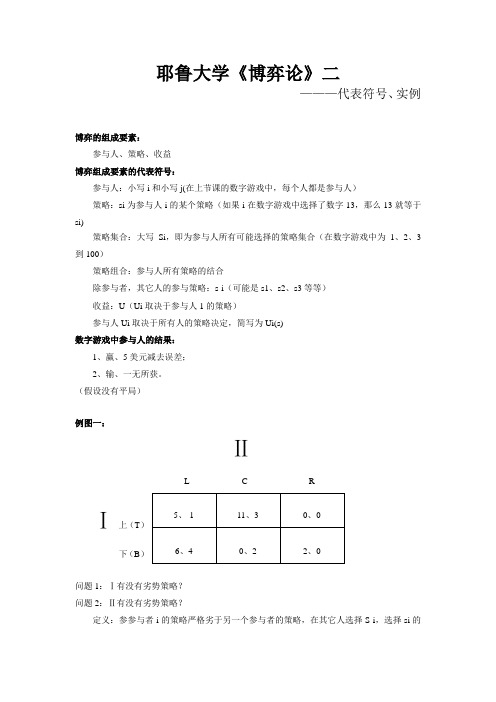
耶鲁大学《博弈论》二
———代表符号、实例
博弈的组成要素:
参与人、策略、收益
博弈组成要素的代表符号:
参与人:小写i 和小写j(在上节课的数字游戏中,每个人都是参与人)
策略:si 为参与人i 的某个策略(如果i 在数字游戏中选择了数字13,那么13就等于si)
策略集合:大写Si ,即为参与人所有可能选择的策略集合(在数字游戏中为1、2、3到100)
策略组合:参与人所有策略的结合
除参与者,其它人的参与策略:s-i (可能是s1、s2、s3等等)
收益:U (Ui 取决于参与人1的策略)
参与人Ui 取决于所有人的策略决定,简写为Ui(s)
数字游戏中参与人的结果:
1、赢、5美元减去误差;
2、输、一无所获。
(假设没有平局)
例图一:
Ⅱ
L C R
Ⅰ 上(T )
下(B )
问题1:Ⅰ有没有劣势策略?
问题2:Ⅱ有没有劣势策略?
定义:参参与者i 的策略严格劣于另一个参与者的策略,在其它人选择S-i ,选择si 的5、-1 11、3 0、0 6、4 0、2 2、0
收益Ui(si)严格优于此情况下选择s’i的收益Ui(s’i);
最重要的是这样的选择必须对所有S-i均成立。
例二
一个侵略者想侵入一个国家,有两条路可以通过,或者可以说成两个管卡,侵略者必须选择通过两个关卡中的一个,这两各关卡,一个关卡道路崎岖,侵略者经过的话会损失一个营,一个关卡平坦宽阔,侵略者经过这个关卡不会损失一兵一卒;
假设你是被侵略国家的将军,你会选择那个关卡防守?假设双方都知道你手上的兵力只能使侵略者损失一个营的兵力;。
耶鲁大学开放课程博弈论笔记

耶鲁大学开放课程博弈论笔记博弈论,是一门研究决策者之间互动行为的学科,它在经济学、政治学、社会学等多个领域发挥着重要作用。
耶鲁大学开放课程中的博弈论课程为我们提供了深入理解和掌握博弈论的机会。
在本篇文章中,我将分享我在学习耶鲁大学开放课程博弈论时所做的笔记和心得体会。
一、博弈论的基本概念和原理1.1 构成博弈论的基本要素博弈论研究的基本要素包括玩家、策略和支付。
玩家是博弈中的决策者,策略是玩家可选择的行动方案,支付是博弈的结果对玩家所产生的效用。
1.2 纳什均衡纳什均衡是博弈论中最重要的概念之一。
在一个博弈中,若每个参与者选择了一个策略,并且没有一个参与者愿意改变自己的策略,那么这种策略组合就被称为纳什均衡。
纳什均衡是一个非合作博弈中的稳定状态。
1.3 合作博弈与非合作博弈博弈论可分为合作博弈和非合作博弈两大类。
合作博弈强调玩家之间的合作与协调,而非合作博弈中玩家之间是相互独立的,没有直接的合作关系。
二、博弈论的应用领域2.1 经济学中的博弈论应用在经济学中,博弈论被广泛应用于市场竞争、拍卖、企业策略等方面。
通过博弈论的模型和方法,我们能够更好地理解各种经济行为和市场现象,并提供决策方案。
2.2 政治学中的博弈论应用政治学中,博弈论主要应用于研究选举、政策制定等政治行为。
博弈论揭示了政治参与者之间的互动关系和利益博弈,为我们分析政治决策提供了一种新的视角。
2.3 社会学中的博弈论应用博弈论在社会学中的应用主要涉及合作与互助、社会规范等方面。
通过博弈论的分析,我们能够更好地理解人类社会中的合作关系、道德行为和社会规范的形成。
三、耶鲁大学开放课程博弈论学习心得在学习耶鲁大学开放课程博弈论的过程中,我深刻体会到博弈论的重要性和应用广泛性。
通过学习博弈论,我不仅了解了博弈论的基本概念和原理,还学会了运用博弈论的方法分析和解决实际问题。
耶鲁大学开放课程博弈论课程的教学内容十分丰富,通过生动的案例分析和实践操作,课程帮助我更好地理解了博弈论的核心思想和应用方法。
(完整版)耶鲁大学公开课博弈论原版资料

Syllabusby (course_default) — last modified 10-14-2008 04:00 PMDocument Actions•This course is an introduction to game theory and strategic thinking. Ideas such as dominance, backward induction, Nash equilibrium, evolutionary stability, commitment, credibility, asymmetric information, adverse selection, and signaling are discussed and applied to games played in class and to examples drawn from economics, politics, the movies, and elsewhere.ECON 159: Game Theory (Fall, 2007)SyllabusProfessor:Ben Polak, Professor of Economics and Management, Yale University Description:This course is an introduction to game theory and strategic thinking. Ideas such as dominance, backward induction, Nash equilibrium, evolutionary stability, commitment, credibility, asymmetric information, adverse selection, and signaling are discussed and applied to games played in class and to examples drawn from economics, politics, the movies, and elsewhere.Texts:A. Dixit andB. Nalebuff. Thinking Strategically, Norton 1991J. Watson. Strategy: An Introduction to Game Theory, Norton 2002P.K. Dutta. Strategies and Games: Theory And Practice, MIT 1999 Requirements:Who should take this course?This course is an introduction to game theory. Introductory microeconomics (115 or equivalent) is required. Intermediate micro (150/2)is not required, but it is recommended. We will use calculus (mostly one variable) in this course. We will also refer to ideas like probability and expectation. Some may prefer to take the course next academic year once they have more background. Students who have already taken Econ 156b should not enroll in this class.Course Aims and Methods.Game theory is a way of thinking about strategic situations. One aim of the course is to teach you some strategic considerations to take into account making your choices. A second aim is to predict how other people or organizations behave when they are in strategic settings. We will see that these aims are closely related. We will learn new concepts, methods and terminology. A third aim is to apply these tools to settings from economics and from elsewhere. The course will emphasize examples. We will also play several games in class.Outline and Reading.Most of the reading for this course comes from the first ten chapters of Dutta or from the first two parts of Watson. There will be a reading packet for weeks 6-7. The readings are not compulsory, but they will help back up the class material.Grading:Problem sets: 30%Midterm examination: 30%Final examination: 40%Transcript 1 - Introduction: five first lessonsby mvd4 — last modified 09-15-2011 09:34 AMDocument Actions•We introduce Game Theory by playing a game. We organize the game into players, their strategies, and their goals or payoffs; and we learn that we should decide what our goals are before we make choices. With some plausible payoffs, our game is a prisoners' dilemma. We learn that we should never choose a dominated strategy; but that rational play by rational players can lead to bad outcomes. We discuss some prisoners' dilemmas in the real world and some possible real-world remedies. With other plausible payoffs, our game is a coordination problem and has very different outcomes: so different payoffs matter. We often need to think, not only about our own payoffs, but also others' payoffs. We should put ourselves in others' shoes and try to predict what they will do. This is the essence of strategic thinking.Game Theory: Lecture 1 TranscriptSeptember 5, 2007 << backChapter 1. What Is Strategy? [00:00:00]Professor Ben Polak:So this is Game Theory Economics 159. If you're here for art history, you're either in the wrong room or stay anyway, maybe this is the right room; but this is Game Theory, okay. You should have four handouts; everyone should have four handouts. There is a legal release form--we'll talk about it in a minute--about the videoing. There is a syllabus, which is a preliminary syllabus: it's also online. And there are two games labeled Game 1 and Game 2. Can I get you all to look at Game 1 and start thinking about it. And while you're thinking about it, I am hoping you can multitask a bit. I'll describe a bit about the class and we'll get a bit of admin under our belts. But please try and lookat--somebody's not looking at it, because they're using it as a fan here--so look at Game 1 and fill out that form for me, okay?So while you're filling that out, let me tell you a little bit about what we're going to be doing here. So what is Game Theory? Game Theory is a。
耶鲁大学的公开课

最近一朋友和我讲,YALE大学把他们上课的内容录了下来,并发布在因特网上,供网络传播浏览。
一个全世界排名第二的大学,竟然把自己课程的内容完全录了下来,并在全世界传播,在大学产业化的中国,有些人会觉得不可思议,你没交学费,怎么可以把我的课程免费的给公众提供呢?可是人家并不是这样认为的,本着人不分贵贱,教育不分你我的原则,耶鲁大学做出了这个匪夷所思的举动,实在是非常钦佩。
好了,不说大话,这个公开课真的非常的好,我有义务分享给我的朋友们首先你得会用电驴,具体怎么用百度去ps:我分享的这个是有字幕的,而且这个字幕是非常考究的,所以出的非常慢,理解一下。
===========================================音乐学聆听音乐Listening to Music(教授本人著述)课程简介:本课程培养在对西方音乐理解基础上对音乐的感悟。
它会介绍各种类型的音乐是如何搭配,并教导如何聆听各种类型的音乐,从巴赫,莫扎特,格里高利咏叹调到蓝调关于课程主讲人:Craig Wright在1966年于the Eastman School获得钢琴乐和音乐史双学位,在1972年于哈佛大学获得博士学位。
Craig Wright从1973年开始在耶鲁大学任教,目前是the Henry L. and Lucy G的音乐教授。
在耶鲁大学,Craig Wright的成就包括常年流行的入门课程“聆听音乐”和选择性研讨会“探索大自然的天才”。
每年夏天,他都会带领一些耶鲁大学的社团区法国,德国和意大利采风。
他的六本著述包括:巴黎圣母院中的音乐(1989)、西方文明中的音乐(2005)、聆听音乐(5th edition, 2007)、聆听西方音乐(2007).他目前的工作是在写作“莫扎特:探索大自然的天才”在2004年Craig Wright被芝加哥大学授予人文学名誉博士学位。
课程安排:1. Introduction导言2. Introduction to Instruments and Musical Genres介绍乐器和音乐风格3. Rhythm: Fundamentals节奏:音乐的基础4. Rhythm: Jazz, Pop and Classical节奏:爵士流行和古典5. Melody: Notes, Scales, Nuts and Bolts旋律:音符,音节,基本细节6. Melody: Mozart and Wagner旋律:莫扎特和瓦格纳7. Harmony: Chords and How to Build Them和声:和弦和如何创建主题8. Bass Patterns: Blues and Rock贝斯风格:布鲁斯和摇滚9. Sonata-Allegro Form: Mozart and Beethoven奏鸣曲式:莫扎特和贝多芬10. Sonata-Allegro and Theme and Variations奏鸣曲式和主题以及主题变奏11. Form: Rondo, Sonata-Allegro and Theme and Variations (cont.)曲式:回旋曲式,奏鸣曲式,主题变奏曲12. Guest Conductor: Saybrook Youth Orchestra客席指挥:布鲁克青年交响乐团13. Fugue: Bach, Bizet and Bernstein赋格:巴赫,比才和伯恩斯坦14. Ostinato Form in the Music of Purcell, Pachelbel, Elton John andVitamin C帕赫贝尔,艾尔顿·约翰音乐中的固定音型15. Benedictine Chant and Music in the Sistine Chapel本尼迪克特教团圣歌和的音乐西斯廷教堂16. Baroque Music: The Vocal Music of Johann Sebastian Bach波洛克音乐:巴赫的声乐作品17. Mozart and His Operas莫扎特和他的歌剧18. Piano Music of Mozart and Beethoven莫扎特和贝多芬的钢琴音乐19. Romantic Opera: Verdi's La Traviata, Bocelli, Pavarotti and Domingo浪漫派歌剧:威尔第的《茶花女》,波切利,帕瓦罗蒂和多明戈20. The Colossal Symphony: Beethoven, Berlioz, Mahler and Shostakovich巨人的交响乐:贝多芬,柏辽兹,马勒,肖斯塔科维奇21. Musical Impressionism and Exoticism: Debussy, Ravel and Monet印象派音乐和异国情调:德彪西,拉威尔和莫奈22. Modernism and Mahler现代主义和马勒23. Review of Musical Style音乐风格的回顾下载地址,电驴会用吧?/topics/2832525/==================================经济学金融市场Financial Markets课程简介:金融机构是文明社会的重要支柱。
(完整word)耶鲁大学博弈论_精简版
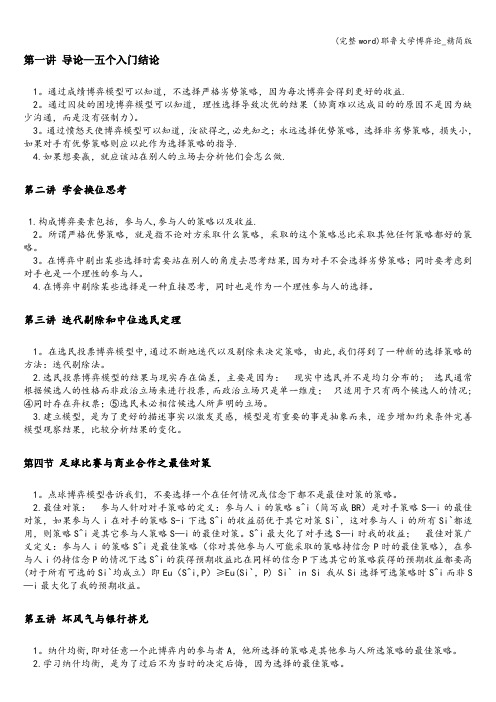
第一讲导论—五个入门结论1。
通过成绩博弈模型可以知道,不选择严格劣势策略,因为每次博弈会得到更好的收益.2。
通过囚徒的困境博弈模型可以知道,理性选择导致次优的结果(协商难以达成目的的原因不是因为缺少沟通,而是没有强制力)。
3。
通过愤怒天使博弈模型可以知道,汝欲得之,必先知之;永远选择优势策略,选择非劣势策略,损失小,如果对手有优势策略则应以此作为选择策略的指导.4.如果想要赢,就应该站在别人的立场去分析他们会怎么做.第二讲学会换位思考1.构成博弈要素包括,参与人,参与人的策略以及收益.2。
所谓严格优势策略,就是指不论对方采取什么策略,采取的这个策略总比采取其他任何策略都好的策略。
3。
在博弈中剔出某些选择时需要站在别人的角度去思考结果,因为对手不会选择劣势策略;同时要考虑到对手也是一个理性的参与人。
4.在博弈中剔除某些选择是一种直接思考,同时也是作为一个理性参与人的选择。
第三讲迭代剔除和中位选民定理1。
在选民投票博弈模型中,通过不断地迭代以及剔除来决定策略,由此,我们得到了一种新的选择策略的方法:迭代剔除法。
2.选民投票博弈模型的结果与现实存在偏差,主要是因为:现实中选民并不是均匀分布的;选民通常根据候选人的性格而非政治立场来进行投票,而政治立场只是单一维度;只适用于只有两个候选人的情况;④同时存在弃权票;⑤选民未必相信候选人所声明的立场。
3.建立模型,是为了更好的描述事实以激发灵感,模型是有重要的事是抽象而来,逐步增加约束条件完善模型观察结果,比较分析结果的变化。
第四节足球比赛与商业合作之最佳对策1。
点球博弈模型告诉我们,不要选择一个在任何情况或信念下都不是最佳对策的策略。
2.最佳对策:参与人针对对手策略的定义:参与人i的策略s^i(简写成BR)是对手策略S—i的最佳对策,如果参与人i在对手的策略S-i下选S^i的收益弱优于其它对策Si`,这对参与人i的所有Si`都适用,则策略S^i是其它参与人策略S—i的最佳对策。
博弈论 耶鲁公开课 笔记及扩展

#共谋和防共谋均衡Coalition and Coalition-proof Equilibrium:在多人(大于两人)博弈中,可能存在部分博弈者追逐小团体利益而 影响纳什均衡的稳定性,与之相对防共谋均衡是指,多人博弈中,任 意n(n=1,2,3.....n)人的串通都不会改变博弈的结果
完美信息指参与者对其他参与者行动action的完全知识的状态,并随信息的出现而更新。比如下象棋中你不可能知道对手下一手棋是 为了吃马还是吃兵或者其他的什么,但是你确确实实知道对手下了一手棋
4.严格劣策略strictly dominated strategy
完全信息动态博弈------------------------------------------------------------------------------------------------------------
5.动态博弈Dynamic Games(序列博弈Sequential Games 多阶段博弈Multistage Games 扩展形博弈Extensive Form Games)
a.基本分析方法(适用范围由小至大):
&1 上策(占优策略Dominant strategy)均衡 :在某个博弈中,不管其他博弈者如何选择,一博弈方的策略带来的效益永远优于选择其 他策略的效益,至少不低于(如囚徒困境中选择坦白)
#帕累托上策均衡Pareto Dominant Equilibrium:在某个博弈当中可能有多个纳什均衡,但这些均衡明显具有优劣差异,所有的博弈方都 倾向于同一个纳什均衡,即其中一个纳什均衡带来的效益优于其他均衡带来的效益(例 如两国交战模型中有两个纳什均衡(战争,战争)(和平,和平)后者明显优于前者)
耶鲁大学博弈论第一章答案

a a a a c
Now player 2 has strategy a weakly dominated by c and player 3 has b weakly dominated by c. The predicted outcome is that player 1,2 and 3 will choose strategy a,c and c respectively and finally winner is player candidate c.
Problem Set 1 Solution
Econ 159a/MGT522a, Yale University
M.Chen momotocmx@
1. Strictly and Weakly Dominated Strategies? A strategy si is a strictly dominated strategy if there exists a strategy si such that si always does strictly better than strategy si no matter what others do, that is ui (si , s−i ) > ui (si , s−i ) for all s−i A strategy si is a weakly dominated strategy if there exists a strategy si such that ui (si , s−i ) ≥ ui (si , s−i ) for all s−i ui (si , s−i ) > ui (si , s−i ) for some s−i ExampБайду номын сангаасe:
[耶鲁大学开放课程:博弈论].Problem.Set.4
![[耶鲁大学开放课程:博弈论].Problem.Set.4](https://img.taocdn.com/s3/m/979168e3524de518964b7d49.png)
明。
(g).有人说 ,在美国当人们生病了去看医生时,他们从来不觉得自己感冒了,而是认为自己是在
“修音响”。请解释一下,为什么人们会认为医生经常欺骗患者不当牟利呢?[提示:可以通过分
析 值对于这个模型的均衡有何影响来入手]
D 5,8 4,2
(a). 找出所有的纳什均衡(包括纯策略纳什均衡和混合策略纳什均衡),并解释说明为何你所找
出的就是所有的纳什均衡。
(b). 假设参与人2的收益 从8减小到6,而其他收益均不变。找出此情况下所有的纳什均衡。
3. 我要修音响(来自Osborne的习题):参与人1的立体音响系统出毛病了,只有一个声道有声。
他不知道需要简单维修 (比如说清理)还是需要彻底维修(比如更换光头)。需要更换光头的概
率为 。在家附近的维修网点里,更换光头的费用是L,而清理的费用是C (其中L>C)。他认识维
修专家-参与人2,参与人2的利润用 表示。她可以选择诚实(收费L为参与人1更换光头或收费C
却在考虑是(y)否(x)要使用他的炸药来制造一次雪崩。博弈的收益如下:
002
x y
a 12,0 0,6
时,001 应该怎么办?
(b). 假如你是耶鲁大学训练出来的 “Queue”先生。作为英国军事情报局的顾问,你会建议001
不要选择哪些路线呢?请说明你的理由。
(c). 热情的观众们现在很想知道这部大片最后的结局是什么样的。请找出一个纳什均衡,使其中
一个参与人采用的是纯策略 而另一个参与人采用的是混合策略 。再找出另外一个纳什均衡使得
其中策略 被赋予概率0。这rse |人人影视博弈论制作小组Darrencui翻译 1
耶鲁大学公开课博弈论教案

课时:2课时教学目标:1. 让学生了解博弈论的基本概念、原理和应用。
2. 培养学生的逻辑思维能力和决策能力。
3. 增强学生对现实生活中的博弈现象的认识。
教学重点:1. 博弈论的基本概念和原理。
2. 博弈论在现实生活中的应用。
教学难点:1. 博弈论模型的构建。
2. 博弈论在实际问题中的应用。
教学过程:第一课时一、导入1. 向学生介绍博弈论的定义和起源。
2. 通过生活中的实例,引导学生关注博弈现象。
二、基本概念1. 介绍博弈论的基本术语,如参与者、策略、收益等。
2. 讲解零和博弈、正和博弈、完全信息博弈和不完全信息博弈等概念。
三、博弈论原理1. 分析纳什均衡、混合策略均衡等核心原理。
2. 通过实例讲解博弈论原理在现实生活中的应用。
四、课堂练习1. 让学生分组讨论,分析一个现实生活中的博弈现象,并尝试运用博弈论原理进行分析。
2. 每组选派代表进行汇报,教师点评。
第二课时一、回顾与总结1. 回顾博弈论的基本概念、原理和应用。
2. 总结学生在课堂练习中的表现。
二、博弈论模型构建1. 介绍博弈论模型的基本要素,如参与者的数量、策略空间、收益矩阵等。
2. 通过实例讲解博弈论模型的构建过程。
三、博弈论在实际问题中的应用1. 分析博弈论在经济学、政治学、心理学等领域的应用。
2. 结合实际案例,讲解博弈论在实际问题中的应用。
四、课堂讨论1. 让学生分组讨论,分析一个与自己专业相关的博弈现象,并尝试运用博弈论原理进行分析。
2. 每组选派代表进行汇报,教师点评。
五、课后作业1. 让学生收集生活中的博弈现象,运用博弈论原理进行分析。
2. 下节课进行汇报。
教学反思:1. 本节课通过理论讲解和实例分析,让学生对博弈论有了初步的认识。
2. 课堂练习和讨论环节,激发了学生的学习兴趣,提高了学生的参与度。
3. 教师在讲解过程中,应注重引导学生思考,培养学生的逻辑思维能力和决策能力。
4. 在今后的教学中,可以结合更多实际案例,让学生更好地理解博弈论的应用。
(完整版)耶鲁公开课--博弈论笔记
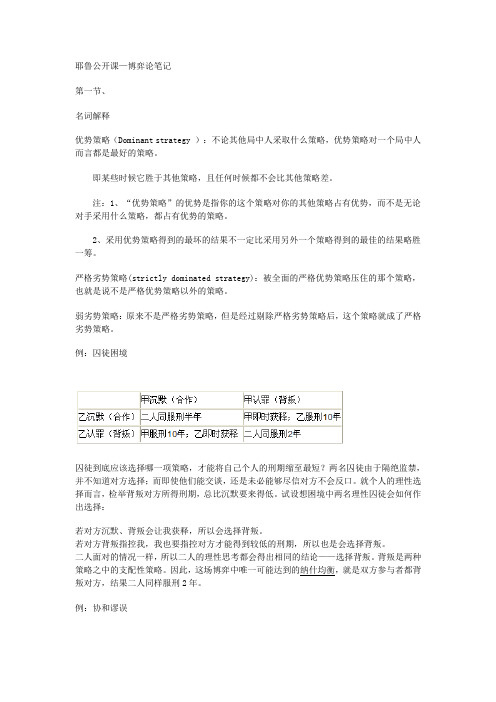
耶鲁公开课—博弈论笔记第一节、名词解释优势策略(Dominant strategy ):不论其他局中人采取什么策略,优势策略对一个局中人而言都是最好的策略。
即某些时候它胜于其他策略,且任何时候都不会比其他策略差。
注:1、“优势策略”的优势是指你的这个策略对你的其他策略占有优势,而不是无论对手采用什么策略,都占有优势的策略。
2、采用优势策略得到的最坏的结果不一定比采用另外一个策略得到的最佳的结果略胜一筹。
严格劣势策略(strictly dominated strategy):被全面的严格优势策略压住的那个策略,也就是说不是严格优势策略以外的策略。
弱劣势策略:原来不是严格劣势策略,但是经过剔除严格劣势策略后,这个策略就成了严格劣势策略。
例:囚徒困境囚徒到底应该选择哪一项策略,才能将自己个人的刑期缩至最短?两名囚徒由于隔绝监禁,并不知道对方选择;而即使他们能交谈,还是未必能够尽信对方不会反口。
就个人的理性选择而言,检举背叛对方所得刑期,总比沉默要来得低。
试设想困境中两名理性囚徒会如何作出选择:若对方沉默、背叛会让我获释,所以会选择背叛。
若对方背叛指控我,我也要指控对方才能得到较低的刑期,所以也是会选择背叛。
二人面对的情况一样,所以二人的理性思考都会得出相同的结论——选择背叛。
背叛是两种策略之中的支配性策略。
因此,这场博弈中唯一可能达到的纳什均衡,就是双方参与者都背叛对方,结果二人同样服刑2年。
例:协和谬误20世纪60年代,英法两国政府联合投资开发大型超音速客机,即协和飞机。
该种飞机机身大、装饰豪华并且速度快,其开发可以说是一场豪赌,单是设计一个新引擎的成本就可能高达数亿元。
难怪政府也会被牵涉进去,竭力要为本国企业提供更大的支持。
项目开展不久,英法两国政府发现:继续投资开发这样的机型,花费会急剧增加,但这样的设计定位能否适应市场还不知道;但是停止研制也是可怕的,因为以前的投资将付诸东流。
随着研制工作的深入,他们更是无法做出停止研制工作的决定。
耶鲁大学开放课程:博弈论
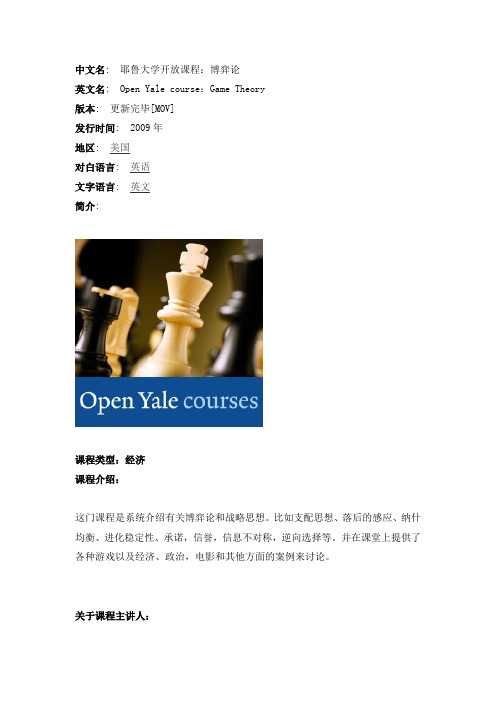
中文名: 耶鲁大学开放课程:博弈论英文名: Open Yale course:Game Theory版本: 更新完毕[MOV]发行时间: 2009年地区: 美国对白语言: 英语文字语言: 英文简介:课程类型:经济课程介绍:这门课程是系统介绍有关博弈论和战略思想。
比如支配思想、落后的感应、纳什均衡、进化稳定性、承诺,信誉,信息不对称,逆向选择等。
并在课堂上提供了各种游戏以及经济、政治,电影和其他方面的案例来讨论。
关于课程主讲人:Ben Polak教授任职于耶鲁大学管理学院经济系。
他在剑桥大学Trinity College 获得学士学位,在西北大学获得硕士学位,在哈佛大学获得博士学位。
他是微观经济理论和经济史方面的专家。
他的论文在Economic Letters、Journal of Economic Theory、Journal of Economic History、Journal of Legal Studies、Journal of Theoretical and Institutional Economics、Econometrica等学术期刊多次发表。
他最近的研究是“广义功利主义和海萨尼的公正观察员定理”和“平均分散的偏好”课程结构:本耶鲁大学课程每周在学校上两次课,每次75分钟,2007年秋季拍摄作为耶鲁大学开放课程之一。
课程视频截图:课程安排:1 Introduction: five first lessons 简介:五年前的教训2 Putting yourselves into other people's shoes 设身处地为他人着想3 Iterative deletion and the median-voter theorem 迭代删除和位数选民定理4 Best responses in soccer and business partnerships 最佳反应在足球和商业伙伴关系5 Nash equilibrium: bad fashion and bank runs 纳什均衡:坏时尚及银行挤兑6 Nash equilibrium: dating and Cournot 什均衡:约会和诺7 Nash equilibrium: shopping, standing and voting on a line 纳什均衡:购物,并参加表决的常委会上线8 Nash equilibrium: location, segregation and randomization 纳什均衡:定位,隔离和随机9 Mixed strategies in theory and tennis 混合战略的理论和网球10 Mixed strategies in baseball, dating and paying your taxes 混合战略棒球,约会和支付您的税11 Evolutionary stability: cooperation, mutation, and equilibrium 进化稳定:合作,突变,与平衡12 Evolutionary stability: social convention, aggression, and cycles 进化稳定:社会公约,侵略,和周期13 Sequential games: moral hazard, incentives, and hungry lions 顺序游戏:道德风险,奖励和饥饿的狮子14 Backward induction: commitment, spies, and first-mover advantages 落后的感应:承诺,间谍,和先行者优势15 Backward induction: chess, strategies, and credible threats 落后的感应:国际象棋,战略和可信的威胁16 Backward induction: reputation and duels 落后的感应:声誉和决斗17 Backward induction: ultimatums and bargaining 落后的感应:最后通牒和讨价还价18 Imperfect information: information sets and sub-game perfection 不完全信息:信息集和子博弈完美19 Subgame perfect equilibrium: matchmaking and strategic investments 子博弈完美均衡:招商引资和战略投资20 Subgame perfect equilibrium: wars of attrition 子博弈完美均衡:战争的消耗21 Repeated games: cooperation vs. the end game 重复博弈:合作与结局22 Repeated games: cheating, punishment, and outsourcing 重复博弈:作弊,惩罚和外包23 Asymmetric information: silence, signaling and suffering education 信息不对称:沉默,信令和苦难教育24 Asymmetric information: auctions and the winner's curse 信息不对称:拍卖和获奖者的诅咒学校介绍:耶鲁大学(Yale University),旧译“耶劳大书院”,是一所坐落于美国康乃狄格州纽黑文市的私立大学,始创于1701年,初名“大学学院”(Collegiate School)。
耶鲁大学《博弈论》第一节课的游戏

耶鲁大学《博弈论》一
———课堂游戏
1、在不被同桌看到的情况下,在□中填写字母α或者字母β,吧这看成成绩的赌注,我会随机把你们分成两两一组,你们不知道会跟谁分到一组,按如下方法给出你们的成绩,如果选择而你的对手选择了α,那么你得A,你对手得C,如果你们都选择了α,那么你们都得B-,如果你选择β,你对选择α,你得C,你对手得A,如果你们都选择β,你们都得B+。
讲解表格:对手
αβ
我
β
注解:表格里的第一个选择是我做出选择后会遇到的结果,相对的,表格里的第二个是对方的结果。
课堂五个结论:1、不要选择劣势策略。
2、耶鲁大学的学生很自私(其实大多人的性格里都有自私的一面)。
3、理性选择导致次优的结果。
4、学会换为思考,站着别人的立场去分析对方想要得到的收益是什么,会做出怎样的选择,对方的优势策略与劣势策略是什么,当然做出选择的同时也要考虑到对方也回这样考虑你的立场,你的选择。
5、汝欲得之,必先知之,如果你想得到什么,必先要明白自己的动机及收益是什么,了解自己的目的。
2、从1到100之间选择一个数字填写到□内,不要让你们的同桌看到,我们会计算全班的平均数,谁选的数字最接近平均数的三分之二,谁就是赢家,赢家的奖金是5美元减去所选数和平均数三分之二差的百分数。
例:三个人分别选择数字,25、5、60。
他们的平均数是(25+5+60)÷3=30,平均数的三分之二等于:30÷3×2=20,在本本例题中最接近平均数三分之二的数字是25,那么相对而言奖金是5美元减去5美分,就是4美元95美分。
耶鲁大学公开课博弈论笔记(博弈论24讲)
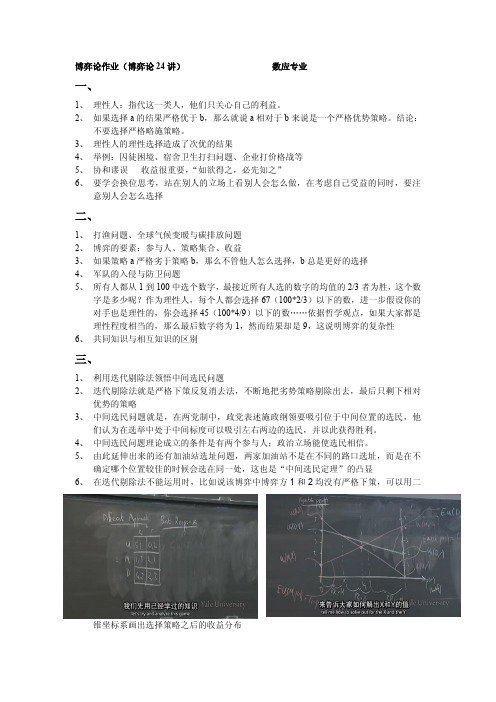
博弈论作业(博弈论24讲)数应专业一、1、理性人:指代这一类人,他们只关心自己的利益。
2、如果选择a的结果严格优于b,那么就说a相对于b来说是一个严格优势策略。
结论:不要选择严格略施策略。
3、理性人的理性选择造成了次优的结果4、举例:囚徒困境、宿舍卫生打扫问题、企业打价格战等5、协和谬误收益很重要,“如欲得之,必先知之”6、要学会换位思考,站在别人的立场上看别人会怎么做,在考虑自己受益的同时,要注意别人会怎么选择二、1、打渔问题、全球气候变暖与碳排放问题2、博弈的要素:参与人、策略集合、收益3、如果策略a严格劣于策略b,那么不管他人怎么选择,b总是更好的选择4、军队的入侵与防卫问题5、所有人都从1到100中选个数字,最接近所有人选的数字的均值的2/3者为胜,这个数字是多少呢?作为理性人,每个人都会选择67(100*2/3)以下的数,进一步假设你的对手也是理性的,你会选择45(100*4/9)以下的数……依据哲学观点,如果大家都是理性程度相当的,那么最后数字将为1,然而结果却是9,这说明博弈的复杂性6、共同知识与相互知识的区别三、1、利用迭代剔除法领悟中间选民问题2、迭代剔除法就是严格下策反复消去法,不断地把劣势策略剔除出去,最后只剩下相对优势的策略3、中间选民问题就是,在两党制中,政党表述施政纲领要吸引位于中间位置的选民,他们认为在选举中处于中间标度可以吸引左右两边的选民,并以此获得胜利。
4、中间选民问题理论成立的条件是有两个参与人;政治立场能使选民相信。
5、由此延伸出来的还有加油站选址问题,两家加油站不是在不同的路口选址,而是在不确定哪个位置较佳的时候会选在同一处,这也是“中间选民定理”的凸显6、在迭代剔除法不能运用时,比如说该博弈中博弈方1和2均没有严格下策,可以用二维坐标系画出选择策略之后的收益分布四、1、罚点球:一个经过模型简化的点球模型:罚球者可以选择左路,中路,右路3种路线去踢点球,门将可以选择向左扑救或者向右扑救(门将没有傻站着不动的option)。
(完整word版)耶鲁大学公开课博弈论原版资料
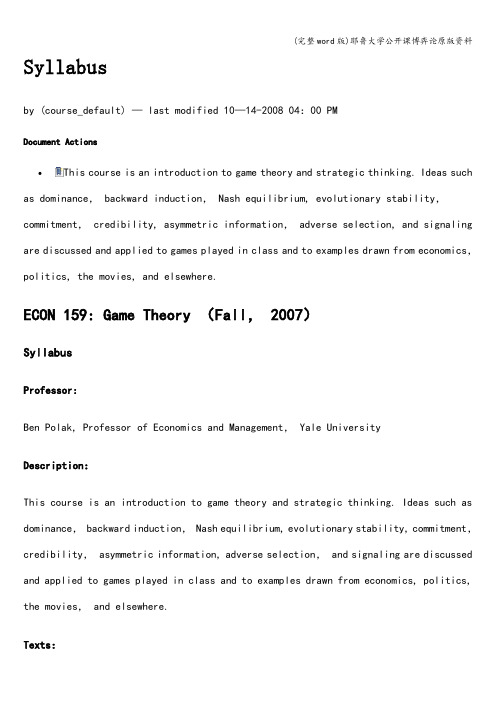
Syllabusby (course_default) — last modified 10—14-2008 04:00 PMDocument Actions•This course is an introduction to game theory and strategic thinking. Ideas such as dominance, backward induction, Nash equilibrium, evolutionary stability,commitment, credibility, asymmetric information, adverse selection, and signaling are discussed and applied to games played in class and to examples drawn from economics,politics, the movies, and elsewhere.ECON 159: Game Theory (Fall, 2007)SyllabusProfessor:Ben Polak, Professor of Economics and Management, Yale UniversityDescription:This course is an introduction to game theory and strategic thinking. Ideas such as dominance, backward induction, Nash equilibrium, evolutionary stability, commitment,credibility, asymmetric information, adverse selection, and signaling are discussed and applied to games played in class and to examples drawn from economics, politics, the movies, and elsewhere.Texts:A。
- 1、下载文档前请自行甄别文档内容的完整性,平台不提供额外的编辑、内容补充、找答案等附加服务。
- 2、"仅部分预览"的文档,不可在线预览部分如存在完整性等问题,可反馈申请退款(可完整预览的文档不适用该条件!)。
- 3、如文档侵犯您的权益,请联系客服反馈,我们会尽快为您处理(人工客服工作时间:9:00-18:30)。
So in this example--sort of trivial game but still--the game looks like this. And suppose we're asked the question what is evolutionarily stable in this game? So no prizes for finding the symmetric Nash Equilibrium in this game. Shout it out. What's the symmetric Nash Equilibrium in this game? (A,A). So (A,A) is a symmetric Nash Equilibrium. That's easy to check. So really the only candidate for an evolutionarily stable strategy here is A. So the second thing you would check is: is (A,A) a strict Nash Equilibrium? So what does strict Nash Equilibrium mean? It means that if you deviate you do strictly worse. So is (A,A) strict Nash? Well is it strict Nash or not? It's not. So if you deviate to B, you notice very quickly that U(A,A) is equal to U(B,A). Is that right? It's just tie, both of these get 1. So it's not a strict Nash Equilibrium so we have to check our third rule. What's our third rule? So we need to check how does A do against the possible deviation which is here--which is B here, how does that compare with B against itself?
So U(A,B) the payoff to A against B is 1 and the payoff to B against itself is 0: 1 is indeed bigger than 0, so we're okay and A is in fact evolutionarily stable. So: just a very, very simple example to illustrate how quick it is to check this idea. I want to spend all of today going over more interesting examples, so having the payoff of having invested in this last time. To start off with, let's get rid of this rather trivial example. I want to think about evolution as it's often applied in the social sciences. So one thing you might talk about in the social sciences is the evolution of a social convention. Sometimes you'll read a lot in sociology or political science about the evolution of institutions or social conventions and things like this--maybe also in anthropology--and I want to see a trivial example of this to see how this might work and to see if we can learn anything. The trivial example I'm going to think about is driving on the left or the right; on the left or right side of the road. So this is a very simple social convention. I think we all can agree this is a social convention and let's have a look at the payoffs in this little game.
October 15, 2007 << back
Professor Ben Polak: All right, I want to talk about evolution again today but just before I do, it's hard not to be a little bit happy today because I woke up this morning and heard on the radio that three game theorists won the Nobel prize this morning, which is very nice. Eric Maskin, Roger Myerson and Leo Hurwicz, all of whom worked in an area called Mechanism Design, which is using game theoryif you like, it's about designing gamesto give people incentives and to try and use information available to society or in a firm, to do as well as you canfigure out how well you can and try to achieve that. So, Mechanism Design, or Incentive Design, we'll just touch on but not really cover in the second half of this classit will goit's something you cover in more detail if you take the follow-up class, in 156, or if you take the Auction seminar later on but this is goodthis is great thing.
All right, so let's move on. So let's go back to evolutionary game theoryI should say one other thingEric Maskin was here two weeks ago in Yale giving a talk, talking about this, talking about evolutionary game theory.
All three of these guys, Hurwicz, Maskin, Myersonthey're incredibly elegant guys, they're incredible intellectuals, you can talk to them about anything. In fact, Maskinhe was my teacher, so I'm getting a biasbut let me talk about Myerson for a second: when I had a job interview years ago at Northwestern, where Myerson was then, I went in there ready to be all nerdy and talk about Economics for half an hour and try and impress Roger Myerson and all he wantedhe realized I was English and had an interest in Historyand all he wanted to talk to me about was Oliver Cromwell. So we talked about Oliver Cromwell for half an hour and I thought that was it, I thought I wouldn't get the job. Well, in fact, I did get the job, so it wasn't so bad. I didn't take the job, but I did get it.
All right, so this was the definition we saw at the end last time. I've tried to write it a bit larger, it just repeats the second of those definitions. This is the definition that connects the notion of evolutionary stability, for now in pure strategies, with Nash Equilibrium. Basically it says this, to check whether a strategy is evolutionarily stable in pure strategies, first check whether (?,?) is a symmetric Nash Equilibrium. And, if it is, if it's a strict Nash Equilibrium we're done. And if it's not strict, that means there's at least another strategy that would tie with ? against ?, then compare how ? does against this mutation with how the mutation does against itself. And if ? does better than the mutation than the mutation does against itself then we're okay. One virtue of this definition is it's very easy to check, so let's try an example to see that and also to get us back into gear and reminding ourselves what we're doing a bit.
